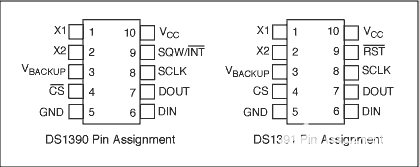

DS1390/DS1391 RTC与带SPI的摩托罗拉DSP接口
描述
本应用笔记介绍如何将DS1390连接至内置SPI™接口模块的摩托罗拉DSP。该威廉希尔官方网站 使用摩托罗拉DSP56F800DEMO演示板和CodeWarrior® IDE。
描述
DS1390实时时钟(RTC)可通过SPI接口与微控制器(μC)或数字信号处理(DSP)单元连接。本应用笔记介绍如何将DS1390连接至内置SPI接口模块的摩托罗拉DSP。该威廉希尔官方网站 使用摩托罗拉DSP56F800DEMO演示板和CodeWarrior IDE。
使用示例软件
示例软件是从空白项目开始开发的。按照摩托罗拉套件安装指南(教程:创建 CodeWarrior 项目)中的说明进行操作,了解详细信息。在main.c中添加本应用笔记中包含的代码。
操作
该程序使用GPIO端口来控制DS1390上的CS。软件初始化SPI控制器模块,DSP将时间和日期写入DS1390。然后,软件循环读取时间和日期。DS1390和DS1391支持SPI模式1和3。
威廉希尔官方网站 原理图如图1所示。该威廉希尔官方网站 包括连接到摩托罗拉演示板的子卡。请注意,图1中的威廉希尔官方网站 包括几个带SPI接口的RTC。一次只能使用一个RTC,软件仅支持DS1390。该软件如图 2 所示。

图1.

图 2.子卡示意图。
图3.代码清单
/* File: DS1390.c */
/* This example program was developed using the Motorola
56F800 Demo Board Kit. Follow the kit instalation guide
for creating a CodeWarrior Project. Use the shell of the
new project for this example. Note: This program is for
example only and is not supported by Dallas Semiconductor
Maxim. */
#include "port.h"
#include "stdio.h"
#include "stdlib.h"
/*******************************************************
* Main program for use with Embedded SDK
*******************************************************/
extern sampleASM (void);
void reset_spi(void);
void wbyte_spi(unsigned char);
void init_sci0(Word16);
tx_sci0(unsigned char);
void bcd2ascii(unsigned char);
unsigned char rbyte_spi(void);
#define REG_BASE 0x0000
#define SCI0_BASE 0x0F00
#define SPI_BASE 0x0F20
#define GPIOA_BASE 0x0FB0
#define GPIOB_BASE 0x0FC0
#define SCI0_SCIBR *(volatile UWord16 *)(SCI0_BASE + 0)
#define SCI0_SCICR *(volatile UWord16 *)(SCI0_BASE + 1)
#define SCI0_SCISR *(volatile UWord16 *)(SCI0_BASE + 2)
#define SCI0_SCIDR *(volatile UWord16 *)(SCI0_BASE + 3)
#define SPSCR *(volatile UWord16 *)(SPI_BASE + 0)
#define SPDSR *(volatile UWord16 *)(SPI_BASE + 1)
#define SPDRR *(volatile UWord16 *)(SPI_BASE + 2)
#define SPDTR *(volatile UWord16 *)(SPI_BASE + 3)
#define GPIO_A_PUR *(volatile UWord16 *)(GPIOA_BASE + 0)
#define GPIO_A_DR *(volatile UWord16 *)(GPIOA_BASE + 1)
#define GPIO_A_DDR *(volatile UWord16 *)(GPIOA_BASE + 2)
#define GPIO_A_PER *(volatile UWord16 *)(GPIOA_BASE + 3)
#define GPIO_B_PUR *(volatile UWord16 *)(GPIOB_BASE + 0)
#define GPIO_B_DR *(volatile UWord16 *)(GPIOB_BASE + 1)
#define GPIO_B_DDR *(volatile UWord16 *)(GPIOB_BASE + 2)
#define GPIO_B_PER *(volatile UWord16 *)(GPIOB_BASE + 3)
void main (void)
{
unsigned char msec=0, min=0x26, sec=0x00, hr=0x17, dow=0x06,
date=0x26, mon=0x12, yr=0x03, write = 0;
reset_spi();
init_sci0(195); // 30MHz / 195 = 9600 baud
GPIO_B_DR = 0x0008; // disable RTC - CS high
GPIO_B_DR = 0; // enable RTC - CS low
wbyte_spi(0x8d); // control register write address
rbyte_spi(); // dummy read
wbyte_spi(0x18); // enable osc, 32kHz sqw
rbyte_spi();
GPIO_B_DR = 0x0008; // disable RTC - CS high
if(write)
{
GPIO_B_DR = 0; // enable RTC - CS low
wbyte_spi(0x80); // select seconds register write address
rbyte_spi(); // dummy read
wbyte_spi(msec); // milliseconds register data
rbyte_spi();
wbyte_spi(sec); // seconds register data
rbyte_spi();
wbyte_spi(min); // minutes register
rbyte_spi();
wbyte_spi(hr); // hours register
rbyte_spi();
wbyte_spi(dow); // day of week register
rbyte_spi();
wbyte_spi(date); // date register
rbyte_spi();
wbyte_spi(mon); // month register
rbyte_spi();
wbyte_spi(yr); // year register
rbyte_spi();
GPIO_B_DR = 0x0008; // disable RTC - CS high
}
while(1)
{
GPIO_B_DR = 0u; // enable RTC - CS low
wbyte_spi(0); // seconds register read address
rbyte_spi(); // dummy read
wbyte_spi(0);
msec = rbyte_spi(); // read milliseconds register
wbyte_spi(0);
sec = rbyte_spi(); // read seconds register
wbyte_spi(0);
min = rbyte_spi(); // ditto minutes
wbyte_spi(0);
hr = rbyte_spi(); // and so on
wbyte_spi(0);
dow = rbyte_spi();
wbyte_spi(0);
date = rbyte_spi();
wbyte_spi(0);
mon = rbyte_spi();
wbyte_spi(0);
yr = rbyte_spi();
GPIO_B_DR = 0x0008; // disable RTC - CS high
tx_sci0(0x0d); // sequence to print time & date
tx_sci0(0x0a);
bcd2ascii(yr);
tx_sci0('/');
bcd2ascii(mon);
tx_sci0('/');
bcd2ascii(date);
tx_sci0(' ');
bcd2ascii(hr);
tx_sci0(':');
bcd2ascii(min);
tx_sci0(':');
bcd2ascii(sec);
}
return;
}
//SPSCR
//15 14 13 12 11 10 9 8 7 6 5 4 3 2 1 0
// r MSB SPRF ERRIE ovrf modf spte modfen spr1 spr0 sprie spmstr cpol cpha spe spite
void reset_spi()
{
int val;
SPSCR = 0x0056; // SPR0, SPMSTR, CPHA, SPE
SPDSR = 0x0007; // 8-bit size
SPSCR &= 0xfffd; // clear spe, resets SPI (partial)
SPSCR |= 0x0002; // set spe, new values take effect
GPIO_B_PER = 0x00f3; // use GPIOB3 as CS for RTC
GPIO_B_DDR = 0x000d; // direction is output
GPIO_A_PER = 0x00f9; // enable/disable per function (1=enable)
GPIO_A_DDR = 0x0006; // direction is output (1=output)
GPIO_A_DR = 0; // write bits low (0=low)
}
void wbyte_spi( unsigned char wbyte) // ------ write one byte -------
{
while (!(SPSCR & 0x0200)); // wait for transmitter empty flag
SPDTR = wbyte;
}
void bcd2ascii(unsigned char dat) // ----- convert bcd to ascii and send to sci ----
{
tx_sci0( (dat >> 4) + 0x30);
tx_sci0( (dat & 0x0f) + 0x30);
}
unsigned char rbyte_spi(void) // -------- read one byte ----------
{
while (!(SPSCR & 0x2000)); // wait for receiver full flag
return(SPDRR);
}
void init_sci0(Word16 baud)
{
GPIO_B_PER = 0x00f3; // set up
GPIO_B_DDR = 0x000d; // direction is output
SCI0_SCIBR = baud; // baud rate
SCI0_SCICR = 0x2000; // control reg
}
tx_sci0(unsigned char val)
{
UWord16 reg;
SCI0_SCICR &= 0xfffb; // turn receiver off
SCI0_SCICR |= 8; // turn transmitter on
do
{
reg = SCI0_SCISR; // clear flag by reading
} while( (reg & 0x8000) == 0); // wait until RDRF is false
SCI0_SCIDR = (unsigned int) (val);
}
审核编辑:郭婷
声明:本文内容及配图由入驻作者撰写或者入驻合作网站授权转载。文章观点仅代表作者本人,不代表电子发烧友网立场。文章及其配图仅供工程师学习之用,如有内容侵权或者其他违规问题,请联系本站处理。
举报投诉
-
摩托罗拉证实裁员计划2008-06-18 0
-
摩托罗拉对讲维修手册2009-10-14 0
-
DS1390/DS1391/DS1394 pdf datas2008-08-10 1028
-
DS1392, DS1393,pdf datasheet (2009-09-03 740
-
Interfacing a DS1390/DS1391 RT2010-04-25 454
-
DS1390/DS1391 RTC与Motorola SPI2009-04-21 1614
-
摩托罗拉手机案例分析2011-05-05 946
-
摩托罗拉Wilder正式发布2011-06-10 928
-
DS1390-DS1394低电压SPI/3线接口RTC2012-11-15 3140
-
DS1390-DS1394数据资料2012-11-15 1382
-
DS1391 RTC2016-03-23 559
-
接口的SPI RTC与摩托罗拉DSP2017-04-12 1006
-
SPI RTC与摩托罗拉DSP接口2023-01-10 1293
-
DS1620与摩托罗拉SPI总线接口2023-05-16 857
全部0条评论

快来发表一下你的评论吧 !

